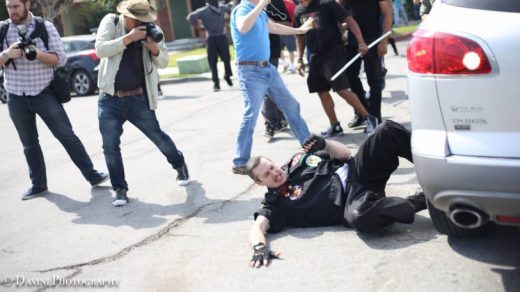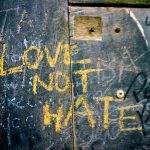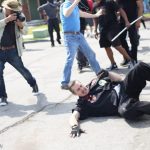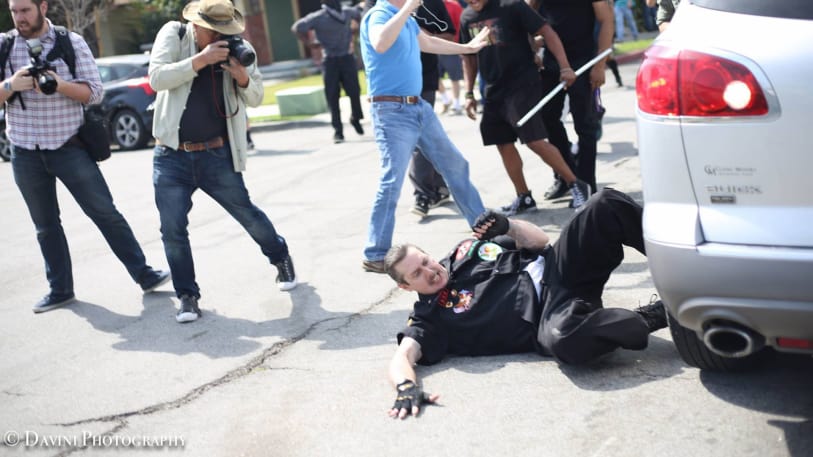How The Internet Fueled The Rise In Hate Crimes In California
Capital & Main is an award-winning publication that reports from California on economic, political, and social issues.
In late February of 2016, the Loyal White Knights of the Ku Klux Klan decided to hold a “White Lives Matter” rally at a public park a couple of miles north of Disneyland.
By all accounts, the rally seemed less a show of force than a last gasp—with the entire white supremacist contingent spilling out of a single SUV. By the time the time the Klansmen arrived at the park, they were far outnumbered by about 50 mostly peaceful counter-demonstrators.
A small group of protesters, however, escalated from getting into the Klansmen’s faces to beating them with sticks, and one of their victims retaliated with a knife—non-fatally as it turned out. William Hagen, grand dragon of the Loyal White Knights in California, might have suffered more than just a cracked rib had not a loose-limbed criminal justice professor and former cop named Brian Levin put himself in front of the dragon’s prone body and begun shouting at his assailants to back off while waiting for the police to arrive.
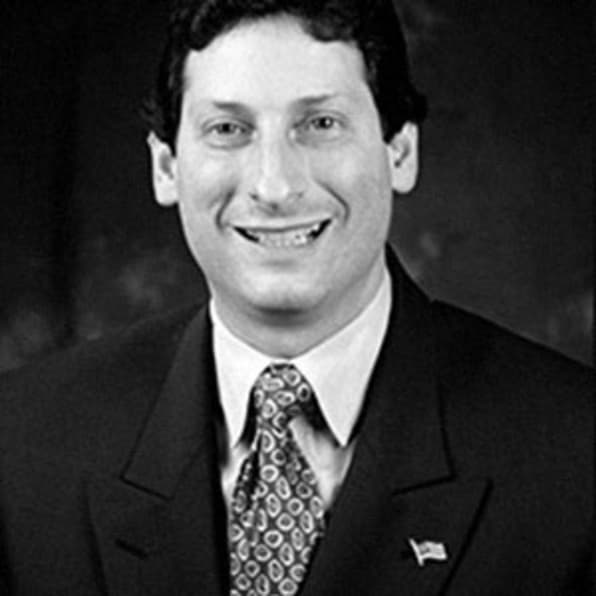
“Who knew in 1985, when I learned those skills at the New York Police Academy, that someday I’d be using them at a Klan rally in Anaheim?” Levin says, with the singsong drawl of a borscht belt comedian. “I wouldn’t have bet money on that.” Who knew, too, that more than three decades later Levin would find himself tracking a national surge in hate crimes, with the Golden State surprisingly at the forefront?
After some years of patrolling Washington Heights and Harlem, Levin left the NYPD and took his undergraduate degree at the University of Pennsylvania and his law degree at Stanford. Two decades ago, as a professor at a small New Jersey college, he launched the Center for the Study of Hate and Extremism, which he moved to California State University, San Bernardino, when he received a teaching position there in 1999. Today, under his aegis, the center is the largest university research organization of its kind.
The center’s report for 2015, the most recent year for which annual statistics are available, reveals a California more roiled by ethnic and religious division than is commonly believed. While the nation experienced a 6.7% increase in hate crimes, California had a 10.4% spike. Anti-Semitic acts of violence and vandalism were up over 21% in California, while the rest of the country saw a 9% jump. The number of hate crimes nationally against Latinos was essentially unchanged from the previous year, while in California, which became a Latino-plurality state in 2014, incidents were up. “Not all of that increase can be laid at the feet of the alt-right,” Levin says. “Turf battles between people of color—in L.A. County particularly—counts for a substantial amount of that increase.”
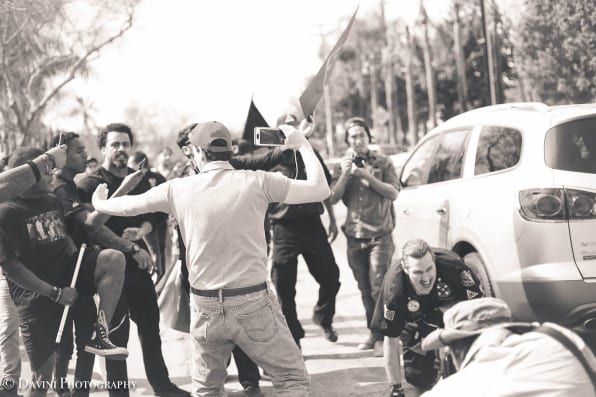
Forget Secession, Will California Break In Two?
The statistics show a state far from unified in standing up to what many Californians regard as the excesses of Trump’s America. “California is on the leading edge of whatever weather pattern is hitting the U.S.,” Levin says, “and I think the same holds for intergroup relationships and politics. We certainly tend to be more of a blue state—but don’t kid yourself. Go to places like Fresno. We talk about California seceding, but there’s also talk of California breaking in two.”
Levin wasn’t reassured by the poor showing of the Loyal White Knights that afternoon in Anaheim, in large part because the surge in bigotry and hate crimes his center was following went far beyond what traditional extremist groups could foment on their own. Rather, he was aware of how deeply their fringe ideas and violent measures had permeated the mainstream through social media and news sites with a surprising subtlety.
Messages about the “otherness” of immigrants have gained an expansive audience. “Bigots have become especially nuanced and skillful at hanging onto the coattails of important public policy debates that are going on in the mainstream,” Levin says. “There’s an online cottage industry that attaches bigotry to real policy issues from national security to free speech on campus to the economy.”
“Some groups continue to promote overt racism and bigotry,” Levin continues, “but some are changing their branding, or toning down the swastikas. And their arguments are no longer that Latinos and immigrants are genetically inferior. It’s that they’re culturally or religiously inapposite to American ideals. Or sometimes the message is shrouded in the idea that we’re under attack from terrorists.”
Scrubbed of the eugenics ideology or race war rhetoric that may have helped spawn them, and freed from the stigma that comes from being the clear intellectual property of Nazi skinheads or the Ku Klux Klan, many of these messages about the otherness of immigrants have gained an expansive audience among Americans who might not embrace them in their raw form. While these views haven’t been given much credence on NBC’s Meet the Press or in the op-ed pages of the Washington Post, they’re regularly part of the conversation on Fox News, and they constitute the bread and butter of breitbart.com—which now enjoys a monthly readership greater than the entire populations of Great Britain, Germany, or France.
Until his fall from alt-right grace last week, British journalist and self-described “free-speech fundamentalist” Milo Yiannopoulos was particularly effective at spreading the alt-right’s loaded messages—both as an editor and a columnist at breitbart.com, and as the heroic subject of articles by other contributors to that website.
Late last October, Breitbart gave ample coverage to a speech Yiannopoulos delivered at the University of California, Irvine. “MILO: ‘Western Civilization’ Is At Stake This Election,” one headline blared. “Let me tell you about where I come from,” Yiannopoulos was quoted in the article. “The U.K. is falling to Islam as we speak. There are whole neighborhoods that are no-go zones, much like the Calais Jungle in France.”
“Here in Irvine, we’re barely an hour from San Bernardino,” he continued, referring to the scene of a 2015 mass shooting that was initially reported as an act of jihad. “Everywhere in America you can see the signs that an alien culture, dedicated to the destruction of the West, is making its presence felt.”
That was Yiannopoulos at his most high-minded. On his “Dangerous Faggot” college speaking tour, he attacked a BuzzFeed News senior tech reporter as “a typical example of a sort of thick-as-pig shit media Jew” and, days before the Republican National Convention, he had been banned for life from Twitter after his tweets unleashed a torrent of online racist harassment against Saturday Night Live and Ghostbusters actress Leslie Jones.
Fifteen years ago, a provocateur like Milo Yiannopoulos would have had his work cut out for him securing 10 minutes to air his views on a cable access channel in Schenectady. But during last year’s presidential election and beyond, as a towering Breitbart superstar, he had the opportunity to reach a potential audience of well over 100 million. As of this writing, according to recent Alexa internet rankings, breitbart.com was the 35th most popular website in the U.S., only nine rungs below nytimes.com and seven spots above washingtonpost.com. As for the Loyal White Knights of the KKK, America’s largest contemporary Klan organization, their website came in at 94,210.
Visitors to breitbart.com and consumers of alt-right-inflected social media feeds can embrace bigoted ideas without becoming card-carrying members of the American Nazi Party or the Klan—and certainly without having disapproving neighbors see them in such a way.

How The “Alt-Right” Is Disrupting Politics As Usual
Social media feeds and incendiary internet news sources had begun eliminating communication barriers to an extreme nationalist agenda some time before Donald Trump declared his candidacy for president. Nevertheless, America’s two-party system had continued to serve as a bulwark against furthering the alt-right’s brand of right-wing populism in Washington—as opposed to the business-friendly, entitlement-slashing programs of leading congressional conservatives like U.S. House Speaker Paul Ryan. “I think it gets lost in the wash sometimes, but the alt-right is not a disruptive movement,” Levin says. “It’s a dismantling movement–a movement to dismantle the Republican party as an effective bloc. Alt-right leaders saw people like John McCain or George H. W. Bush, who signed the original 1990 Hate Crimes Act, and any other Republicans who would speak out against bigotry, as enemies.”
Early in his campaign, Trump predicted he’d be able to mend fences for an increasingly polarized America. “I will be a great unifier for our country,” he assured CNN’s Jake Tapper in October of 2015. By calling for a Muslim ban and for mass deportations of undocumented Mexican immigrants, by declaring that Hillary Clinton should be put behind bars, by disparaging the Black Lives Matter movement, by declining to repudiate David Duke, or to make any mention of six million Jewish victims in his presidential message for International Holocaust Remembrance Day 2017, Trump didn’t exactly bring a divided nation closer together. But he did manage to join hands among bigots, white nationalists, and separatists from all factions. “What has been so fascinating yet disturbing,” says Levin, “and what I haven’t seen in all my professional lifetime—is the unanimity [of] racist and anti-Semitic groups in their support for a mainstream, victorious candidate.”
For the most part, there has been massive yet peaceful pushback against Trump during his first 100 days in office—the women’s marches, the “Not My President’s Day” rallies, and the tongue lashings that some Republican members of Congress have recently undergone at town halls back in their districts. What concerns Levin is the prospect of the extralegal activity of the extreme left finding a larger audience in the wake of the punishing defeat of a centrist Democrat at the polls, and an electoral process that made the likes of former Breitbart executive chair Steve Bannon arguably the most influential shaper of America’s public policy. “The situation now gives license for the fringes on the left to say, ‘Resistance must include violence,’” Levin says.
By Any Means Necessary, for example, is a Bay Area group whose program of protecting immigrant rights and affirmative action has included attacking neo-Nazis on college campuses. While the group garners less than 1,900 followers on its Twitter feed, one of its chief organizers did manage to get its message out on Tucker Carlson Tonight on Fox.
Levin’s organization has tracked others. “We’re seeing the violence by far leftists against people they regard as Nazis—whether it’s Richard Spencer [the white nationalist punched in the face by a masked assailant on Trump’s inauguration day], or the Traditional Workers Party or the Klan.” Yiannopoulos’s planned address at the University of California, Berkeley, was shut down when rioters smashed windows and set fires.
Although Levin’s center has monitored hate crimes across the country, he contends that the media’s recent focus on violent acts by extremists is masking a shift in the mainstream national discourse that is equally troubling. “What we’re seeing now is a coarsening of society that encompasses both [verbal violence] and bigotry, aside from criminal acts,” he says. “We have so much more intergroup conflict, involving so many different variables—not only traditional bigotry, but also those relating to class education, and employment.”
The rise in incivility can be seen in recent letters to the editor justifying the harsh treatment of today’s undocumented immigrants and of Japanese-Americans interred during World War II, in the verbal pipe bombs hurled across college campuses from the left and the right, in the threatening letters sent to synagogues and mosques, in the ease with which some Americans will mock women in burqas or tar all Muslims with the same broad brush.
“We’re at the place now where legitimate policy debates are turning into something more nefarious, more bigoted, and more insular,” Levin says. “A place where hate crime might be as much of the symptom as the cause.”
Fast Company , Read Full Story
(60)

